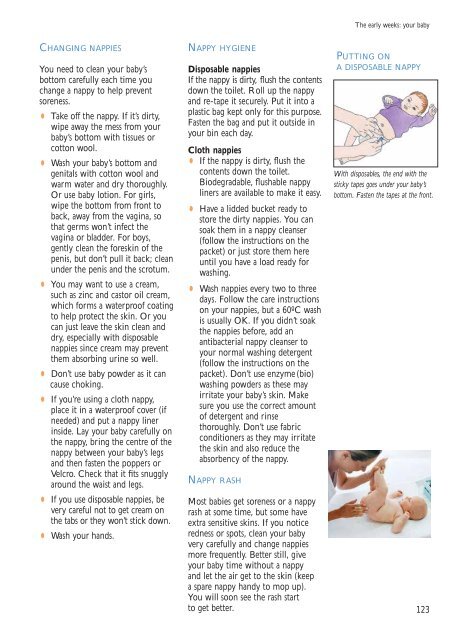here - Health Promotion Agency
here - Health Promotion Agency
here - Health Promotion Agency
You also want an ePaper? Increase the reach of your titles
YUMPU automatically turns print PDFs into web optimized ePapers that Google loves.
The early weeks: your baby<br />
CHANGING NAPPIES<br />
You need to clean your baby’s<br />
bottom carefully each time you<br />
change a nappy to help prevent<br />
soreness.<br />
•<br />
Take off the nappy. If it’s dirty,<br />
wipe away the mess from your<br />
baby’s bottom with tissues or<br />
cotton wool.<br />
•<br />
Wash your baby’s bottom and<br />
genitals with cotton wool and<br />
warm water and dry thoroughly.<br />
Or use baby lotion. For girls,<br />
wipe the bottom from front to<br />
back, away from the vagina, so<br />
that germs won’t infect the<br />
vagina or bladder. For boys,<br />
gently clean the foreskin of the<br />
penis, but don’t pull it back; clean<br />
under the penis and the scrotum.<br />
•<br />
You may want to use a cream,<br />
such as zinc and castor oil cream,<br />
which forms a waterproof coating<br />
to help protect the skin. Or you<br />
can just leave the skin clean and<br />
dry, especially with disposable<br />
nappies since cream may prevent<br />
them absorbing urine so well.<br />
•<br />
•<br />
Don’t use baby powder as it can<br />
cause choking.<br />
If you’re using a cloth nappy,<br />
place it in a waterproof cover (if<br />
needed) and put a nappy liner<br />
inside. Lay your baby carefully on<br />
the nappy, bring the centre of the<br />
nappy between your baby’s legs<br />
and then fasten the poppers or<br />
Velcro. Check that it fits snuggly<br />
around the waist and legs.<br />
NAPPY<br />
• If you use disposable nappies, be<br />
very careful not to get cream on<br />
the tabs or they won’t stick down.<br />
• Wash your hands.<br />
HYGIENE<br />
Disposable nappies<br />
If the nappy is dirty, flush the contents<br />
down the toilet. Roll up the nappy<br />
and re-tape it securely. Put it into a<br />
plastic bag kept only for this purpose.<br />
Fasten the bag and put it outside in<br />
your bin each day.<br />
Cloth nappies<br />
• If the nappy is dirty, flush the<br />
contents down the toilet.<br />
Biodegradable, flushable nappy<br />
liners are available to make it easy.<br />
•<br />
Have a lidded bucket ready to<br />
store the dirty nappies. You can<br />
soak them in a nappy cleanser<br />
(follow the instructions on the<br />
packet) or just store them <strong>here</strong><br />
until you have a load ready for<br />
washing.<br />
•<br />
Wash nappies every two to three<br />
days. Follow the care instructions<br />
on your nappies, but a 60ºC wash<br />
is usually OK. If you didn’t soak<br />
the nappies before, add an<br />
antibacterial nappy cleanser to<br />
your normal washing detergent<br />
(follow the instructions on the<br />
packet). Don’t use enzyme (bio)<br />
washing powders as these may<br />
irritate your baby’s skin. Make<br />
sure you use the correct amount<br />
of detergent and rinse<br />
thoroughly. Don’t use fabric<br />
conditioners as they may irritate<br />
the skin and also reduce the<br />
absorbency of the nappy.<br />
NAPPY RASH<br />
Most babies get soreness or a nappy<br />
rash at some time, but some have<br />
extra sensitive skins. If you notice<br />
redness or spots, clean your baby<br />
very carefully and change nappies<br />
more frequently. Better still, give<br />
your baby time without a nappy<br />
and let the air get to the skin (keep<br />
a spare nappy handy to mop up).<br />
You will soon see the rash start<br />
to get better.<br />
PUTTING ON<br />
A DISPOSABLE NAPPY<br />
With disposables, the end with the<br />
sticky tapes goes under your baby’s<br />
bottom. Fasten the tapes at the front.<br />
123

















